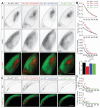Spatial pattern of spontaneous retinal waves instructs retinotopic map refinement more than activity frequency
- PMID: 25787992
- PMCID: PMC4697738
- DOI: 10.1002/dneu.22288
Spatial pattern of spontaneous retinal waves instructs retinotopic map refinement more than activity frequency
Abstract
Spontaneous activity during early development is necessary for the formation of precise neural connections, but it remains uncertain whether activity plays an instructive or permissive role in brain wiring. In the visual system, retinal ganglion cell (RGC) projections to the brain form two prominent sensory maps, one reflecting eye of origin and the other retinotopic location. Recent studies provide compelling evidence supporting an instructive role for spontaneous retinal activity in the development of eye-specific projections, but evidence for a similarly instructive role in the development of retinotopy is more equivocal. Here, we report on experiments in which we knocked down the expression of β2-containing nicotinic acetylcholine receptors (β2-nAChRs) specifically in the retina through a Cre-loxP recombination strategy. Overall levels of spontaneous retinal activity in retina-specific β2-nAChR mutant mice (Rx-β2cKO), examined in vitro and in vivo, were reduced to a degree comparable to that observed in whole animal β2-nAChR mouse mutants (β2KO). However, many residual spontaneous waves in Rx-β2cKO mice displayed local propagating features with strong correlations between nearby but not distant RGCs typical of waves observed in wild-type (WT) but not β2KO mice. We further observed that eye-specific segregation was disrupted in Rx-β2cKO mice, but retinotopy was spared in a competition-dependent manner. These results suggest that propagating patterns of spontaneous retinal waves are essential for normal development of the retinotopic map, even while overall activity levels are significantly reduced, and support an instructive role for spontaneous retinal activity in both eye-specific segregation and retinotopic refinement.
Keywords: activity-dependent; retinotopy; vision.
© 2015 Wiley Periodicals, Inc.
Figures








Similar articles
-
An instructive role for patterned spontaneous retinal activity in mouse visual map development.Neuron. 2011 Jun 23;70(6):1115-27. doi: 10.1016/j.neuron.2011.04.028. Neuron. 2011. PMID: 21689598 Free PMC article.
-
Retinal Wave Patterns Are Governed by Mutual Excitation among Starburst Amacrine Cells and Drive the Refinement and Maintenance of Visual Circuits.J Neurosci. 2016 Mar 30;36(13):3871-86. doi: 10.1523/JNEUROSCI.3549-15.2016. J Neurosci. 2016. PMID: 27030771 Free PMC article.
-
Evidence for an instructive role of retinal activity in retinotopic map refinement in the superior colliculus of the mouse.J Neurosci. 2005 Jul 20;25(29):6929-38. doi: 10.1523/JNEUROSCI.1470-05.2005. J Neurosci. 2005. PMID: 16033903 Free PMC article.
-
Spontaneous patterned retinal activity and the refinement of retinal projections.Prog Neurobiol. 2005 Jul;76(4):213-35. doi: 10.1016/j.pneurobio.2005.09.002. Epub 2005 Nov 8. Prog Neurobiol. 2005. PMID: 16280194 Review.
-
Activity dependent mechanisms of visual map formation--from retinal waves to molecular regulators.Semin Cell Dev Biol. 2014 Nov;35:136-46. doi: 10.1016/j.semcdb.2014.08.008. Epub 2014 Aug 22. Semin Cell Dev Biol. 2014. PMID: 25152335 Review.
Cited by
-
Activity-dependent synapse clustering underlies eye-specific competition in the developing retinogeniculate system.bioRxiv [Preprint]. 2024 Oct 22:2023.09.28.560055. doi: 10.1101/2023.09.28.560055. bioRxiv. 2024. PMID: 39484601 Free PMC article. Preprint.
-
Epigenetic and Transcriptional Regulation of Spontaneous and Sensory Activity Dependent Programs During Neuronal Circuit Development.Front Neural Circuits. 2022 May 18;16:911023. doi: 10.3389/fncir.2022.911023. eCollection 2022. Front Neural Circuits. 2022. PMID: 35664458 Free PMC article. Review.
-
Activity-dependent development of visual receptive fields.Curr Opin Neurobiol. 2017 Feb;42:136-143. doi: 10.1016/j.conb.2016.12.007. Epub 2017 Jan 11. Curr Opin Neurobiol. 2017. PMID: 28088066 Free PMC article. Review.
-
Circuit mechanisms underlying embryonic retinal waves.Elife. 2023 Feb 15;12:e81983. doi: 10.7554/eLife.81983. Elife. 2023. PMID: 36790167 Free PMC article.
-
Whole-Retina Reduced Electrophysiological Activity in Mice Bearing Retina-Specific Deletion of Vesicular Acetylcholine Transporter.PLoS One. 2015 Jul 30;10(7):e0133989. doi: 10.1371/journal.pone.0133989. eCollection 2015. PLoS One. 2015. PMID: 26226617 Free PMC article.
References
-
- Bansal A, Singer JH, Hwang BJ, Xu W, Beaudet A, Feller MB. Mice lacking specific nicotinic acetylcholine receptor subunits exhibit dramatically altered spontaneous activity patterns and reveal a limited role for retinal waves in forming ON and OFF circuits in the inner retina. J. Neurosci. 2000;20:7672–81. - PMC - PubMed
MeSH terms
Substances
Grants and funding
LinkOut - more resources
Full Text Sources
Other Literature Sources
Molecular Biology Databases

